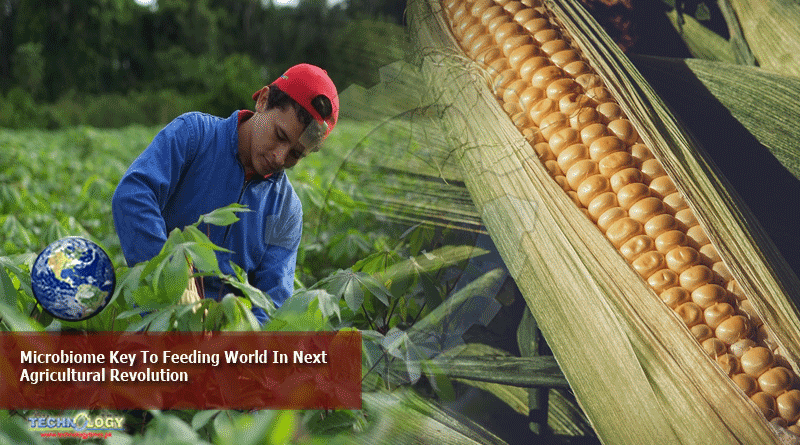The Key To The Next Agricultural Revolution? A National Task Force Releasing A Scientific Paper Today Says The Answer Lies In The Microbiome

The communities of microorganisms that co-exist on, in and near plants.
According to Ignazio Carbone and Megan Andrews, scientists with NC State ties who co-chaired the task force, “Past success with microbial solutions combined with new understanding and technology has great promise to lead to the agricultural revolution required to continue to feed our world.”
Achieving that promise, they say, will require increased funding and better infrastructure for related research, more interdisciplinary collaboration, and improved strategies for science communication, public engagement, product regulation and policy development.
The task force’s paper, published by the Council for Agricultural Science and Technology, is available for free download.
Carbone, a professor in NC State’s Department of Entomology and Plant Pathology and Andrews, a project manager who recently left the university, will lead a webinar on task force findings at 1 p.m. Eastern time on Tuesday, Aug. 25. Carbone and Andrews will share publication highlights, and their remarks will be followed by a panel discussion and a question-and-answer session with several of the paper’s authors. Registration for the free webinar can be made here.
WHY THE TIME IS RIGHT
The publication’s authors say that today’s agricultural challenges are alarming: The world population is growing quickly, but the amount of cropland per capita has declined, available farmland is being consumed by urban development at unprecedented rates, the climate is changing, and crop yields are plateauing.
Now, they say, the time is right to focus on the plant microbiome as a source of agricultural solutions for improving crop productivity.
Researchers now have a better understanding of just how complex plant-soil-microbe interactions can be.
“Researchers now have a better understanding of just how complex plant-soil-microbe interactions can be,” Carbone and Andrews say. “Current advances in technology and data processing now make it possible to collect and analyze the enormous amounts of data needed to study this level of complexity, and growing support for stewardship of the land and environment call for solutions to increase crop yields while reducing chemical and water inputs.”
Carbone said new methodologies will “allow researchers to identify a larger proportion of the microbiome and thus generate a more complete picture of who is present in a complex microbiome sample.”
COMMUNICATION, REGULATIONS, FUNDING MAKE A DIFFERENCE
How risky or beneficial people see a technology can be tightly related to the ties that a person has to others.
Putting that knowledge to work through the production of new biological products can take time and can involve many regulations. Cutting-edge technologies make microbial data useful, but to be successfully used, they must be effectively communicated to public audiences.
As task force member Andrew Binder, of NC State’s Department of Communication, says, “Even the evaluation of how risky or beneficial people see a technology can be tightly related to the ties that a person has to others in their family, among friends, and in their broader community.”
TASK FORCE MAKES SIX RECOMMENDATIONS
Harnessing the power of microbes, the task force notes, will require investments in interdisciplinary education, research and technologies, new partnerships and new models for education and training. The task force report concludes with six recommendations:
Commit resources for research and infrastructure development to advance understanding the dynamic complexity of the phytobiome – the plant and the community of microbes, animals and the geophysical environment that influence the plant
Fund development and application of cutting-edge technologies – such as machine learning, precision agriculture and sensors – relevant to agricultural microbiome research
Bring scientists, social scientists and stakeholders together to develop strategies around communication, public engagement, product regulation and policy development for microbiome-based solutions
Increase funding and incentives for interdisciplinary research, education and training in the agricultural and microbiome fields
Encourage new models for training graduate students to increase cross-disciplinary literacy, team work abilities and communication skills
Encourage industry-academic partnerships and provide programs and funds to help bridge the gap between promising lab results and successful field trails related to crop microbes
At NC State, Carbone and Andrews say, the North Carolina Plant Sciences Initiative has positioned the university and its partners to help tackle the task force recommendations by leveraging strong interdisciplinary teams of scientists at NC State and long-standing relationships with agricultural biotechnology companies and commodity groups.
INDUSTRY-UNIVERSITY PARTNERSHIPS ARE IMPORTANT
They say that it’s critical for academia and industry to work together to accelerate the discovery and commercialization of new microbe-based agricultural solutions.
Right now, Carbone and his colleagues are researching how microbes are evolving in agricultural fields; whether microbial community structure is influenced by the plants and other organisms that occupy the same space; and the genetic mechanisms that allow microbes to rapidly respond to environmental perturbations like drought, flood, nutrient shortages, or plant diseases.
In addition to Andrews, Carbone and Binder, task force authors are Natalie Breakfield, NewLeaf Symbiotics; Owen Duckworth, North Carolina State University; Kirk Francis, BASF; Susanna L. Harris, University of North Carolina at Chapel Hill; Linda Kinkel, University of Minnesota; Jan Leach, Colorado State University: Gregory Maloney, Novozymes North America, Inc.; Kelci Miclaus, SAS Institute, Inc.; Elizabeth Shank, University of Massachusetts Medical School; Elizabeth Stulberg, Alliance of Crop, Soil, and Environmental Science Societies; Carolyn Young, Noble Research Institute; and Sherryl Yu-Su, Novozymes North America, Inc.
The Council for Agricultural Science and Technology is an international consortium of scientific and professional societies, companies, and nonprofit organizations. Through its network of experts, CAST assembles, interprets, and communicates credible, balanced, science-based information to policymakers, the media, the private sector, and the public.
This news was originally published at wraltechwire.com
